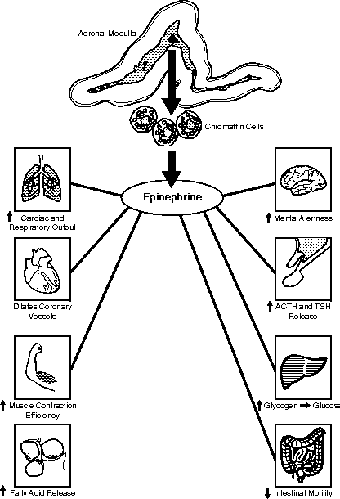Anatomy and Physiology: Kidneys: Not Just for Urine!
Kidneys: Not Just for Urine!
The Big Picture
One thing that's ironic about the endocrine system is the fact that all the hormones, despite specific targets, travel all over the body via the blood. In some cases this is just plain silly! Think about aldosterone. Released from the adrenal glands, it must pass all the way through the body before it gets to its target, just centimeters away! Even sillier is renin, which has to travel all over the body to get converted into angiotensin II, despite taking effect just a few microns away from where renin is first made!
Homeostasis is an amazing thing, especially for the sentient; to be sentient, by definition, is to be self-aware. Despite all our emphasis on our own thoughts, when we are conscious of hunger and thirst, we are merely responding to the effects of our hormones! In response to low blood volume (and thus not enough water) antidiuretic hormone (ADH) from the neurohypophysis increases our reabsorption of water (see The Excretory System) in the kidneys, which, in turn, increases blood volume.
When blood volume gets too low, the release of ADH is triggered by the release of renin from the juxtaglomerular apparatus (see The Excretory System). Renin then converts the inactive angiotensinogen into angiotensin I; then in the lungs, of all places, an enzyme (angiotensinconverting enzyme) converts angiotensin I into angiotensin II. It's a good thing it gets converted by the lungs, for angiotensin can then make its way to the thirst centers, as well as stimulating the release of ADH.
As if that weren't enough, angiotensin II stimulates the adrenal glands to release aldosterone, which tells the kidneys to hang on to more Na+, which in turn helps the kidneys to reabsorb water. Don't worry though, because the kidneys aren't done yet! With so much access to RBC (red blood cells or erythrocytes, see The Blood), the kidneys can sense the oxygen levels in the blood (directly correlated to the number of RBCs) and can respond to low levels through the release of erythropoietin (EPO). If you assumed from the name, and from the context, that EPO stimulates erythrocyte production, good job!
Adrenals: The Kidneys' Lofts
The adrenal glands, or suprarenal glands, lie on top of the kidneys, as the name implies (ad = attached, renal = kidney). These glands are about the level of the twelfth rib, although the right kidney is slightly lower, due to the space taken up by the liver. There is a fibrous capsule around the adrenal gland that helps keep it attached there. Similar to so many organs, there is an outer cortex surrounding the medulla in the middle (sounds like a TV show). I emphasize these, as the hormones are divided according to the location of their production.
The medulla is stimulated by the sympathetic branch of the autonomic nervous system (see The Central and Peripheral Nervous Systems). There are two medullary hormones: epinephrine (formerly called adrenalin) and norepinephrine. Both hormones function as neurotransmitters (see The Nervous System, which are released by neuroendocrine cells (neurons that produce hormones). These hormones target most cells in the body.
One of the main effects of these two hormones is the increase in the rate of glycolysis and cellular respiration, as well as to initiate glycogenolysis (the breakdown of glycogen into glucose molecules). In addition, the heart rate becomes elevated, breathing becomes faster and deeper, respiratory bronchioles dilate (hence the use of epinephrine to combat systemic allergic reactions), and lipids are released by adipose tissue (see Figure 18.5).

Figure 18.5The effect of epinephrine on various organs of the body. (LifeART©1989-2001, Lippincott Williams & Wilkins)
The adrenal cortex produces three types of hormones: mineralocorticoids, glucocorticoids, and androgens. Mineralocorticoids, such as aldosterone, target the kidneys, and help to regulate ions in the body, such as Na+. Glucocorticoids, such as cortisol, corticosterone, and cortisone, on the other hand, are involved with glycogen production (gluconeogenesis), glucose synthesis, and the release of fatty acids from adipose tissue (thus reserving glucose for storage as glycogen). Glucocorticoids are stimulated by the release of ACTH from the adenohypophysis; without these steroids we would die within a week! Androgens are the same as those made by the testes, and in females they are converted to estrogen. Although androgen production is also stimulated here by ACTH, the amounts are very small, and are little understood.

Excerpted from The Complete Idiot's Guide to Anatomy and Physiology © 2004 by Michael J. Vieira Lazaroff. All rights reserved including the right of reproduction in whole or in part in any form. Used by arrangement with Alpha Books, a member of Penguin Group (USA) Inc.
To order this book direct from the publisher, visit the Penguin USA website or call 1-800-253-6476. You can also purchase this book at Amazon.com and Barnes & Noble.







